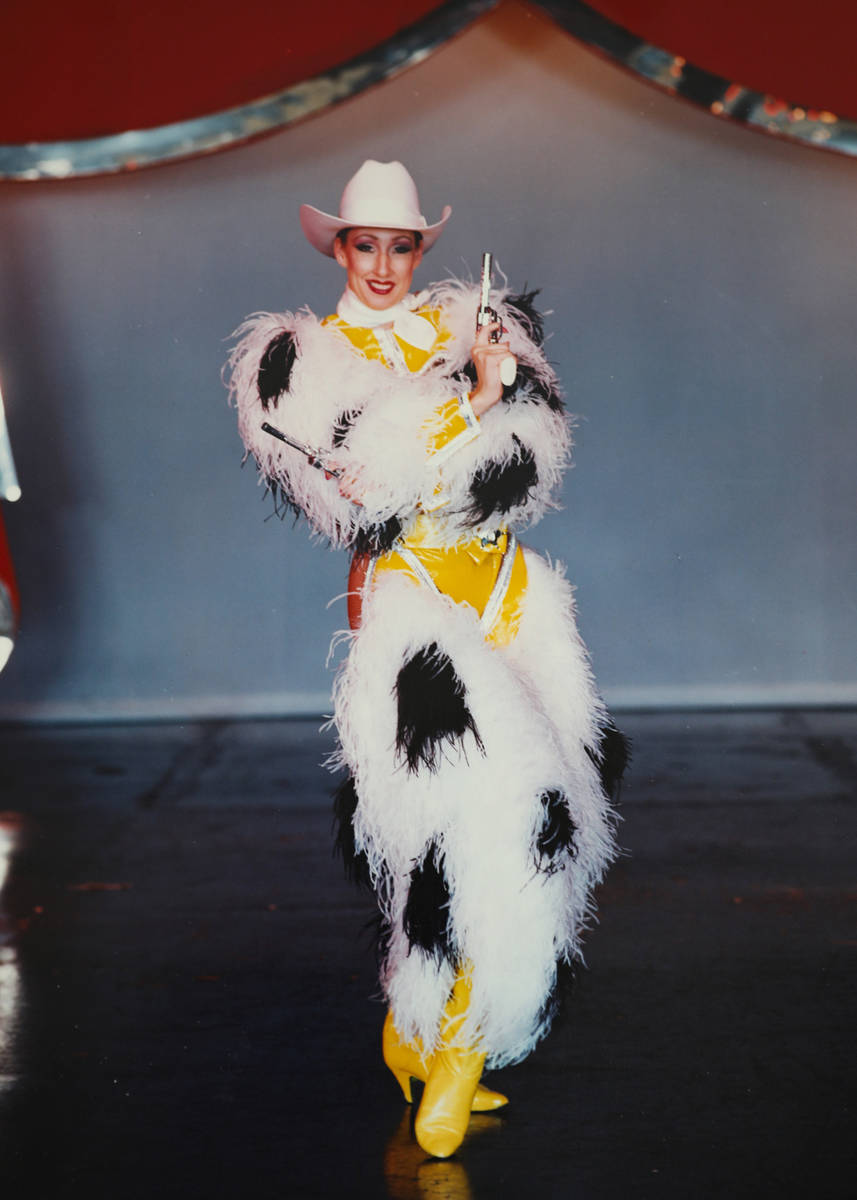Ex-showgirl now raises awareness of breast implant risks
Jacqueline Koenig’s photo album documents her years as a professional dancer and Las Vegas showgirl, donned in sequins and feathers and sometimes very little else. Absent are images of her in a wheelchair, when she was at the lowest point of a mysterious illness that claimed years of her life.
The willowy 5-foot-11-inch brunette believes the breast implants she got to boost her career led to the years of increasingly debilitating symptoms. Beginning with anxiety and migraines, her symptoms progressed to where she could hardly get out of bed.
“I couldn’t eat, I couldn’t walk, I couldn’t talk,” the 59-year-old Las Vegas resident said. Worse, “I couldn’t think.”
As a last resort, Koenig underwent controversial detoxification treatments that she largely credits with restoring her health. She plans to share her story in a book she is writing and in an art installation, which she hopes will make more women think twice before getting implants.
“Be very careful and be forewarned,” she said. “ If you go to a plastic surgeon, you’re not going to a doctor who’s there to get you well. They’re there to get you a product to make you feel a certain way about yourself.”
Symptoms begin, multiply
After the birth of her first child in her late 20s, the classically trained dancer got her first set of implants in 1990, which she said helped her get work in large production shows. For the next two decades, Koenig performed, choreographed and taught dance, while raising her two children, a daughter and son.
In her 30s, she began to have severe anxiety and migraines. “And I was not an anxious person,’ she said. “I was a performer. I always had been able to focus and get in the zone.”
Her symptoms multiplied to include “brain fog,” digestive problems, tremors and widespread pain. Doctors eventually diagnosed her with Hashimoto’s thyroiditis, an autoimmune disease that affects the thyroid, but the diagnosis did not explain the range and severity of her symptoms.
After learning that one of her silicone and saline implants had ruptured, Koenig in 2015 had them replaced with so-called “gummy bear” silicone implants. Her surgeon told her she would hate the way she looked without implants after having had them for years.
After the surgery, she felt worse. She read books and online accounts of women who described symptoms identical to hers and who attributed them to implants. She shared her concerns about implants with her doctors, most of whom dismissed them.
“It was so frustrating because I really respected my doctors,” she said.
After having her second set of implants removed in 2016, her health deteriorated to where she was bedridden.
Her husband, Frank, who initially questioned the seriousness of his wife’s condition, became determined to help her find relief.
“These symptoms are real. You have to believe your eyes at some point,” he said. “It’s not psychological. It’s not imagined.”
“It’s not manufactured, it’s real, it exists, and it’s getting worse, and we don’t have an explanation, but we can’t stop,” he said. “What kept me going was I knew this is not the person I married.”
At the suggestion of a sympathetic Las Vegas doctor, the couple and their son in 2017 trekked across the country in an RV — Koenig was too sick to fly — to a Florida clinic specializing in detoxification treatments. (The clinic, the Sponaugle Wellness Institute, has been sued for malpractice over its unconventional methods while also receiving praise from patients who say they were helped, according to news reports.)
Koenig got sicker in Florida before she got better, landing in the hospital for five days with a bowel obstruction. Nine months later and feeling somewhat improved, she returned home, where her symptoms continued to subside.
The couple spent $400,000 to $500,000 out-of-pocket on various treatments, Koenig’s husband said.
Although most of her symptoms are gone, she continues to have widespread pain, which she treats with a non-opioid pain medication. She is still coming to terms with the “years of pain and hell.”
Safety questions remain
Since their introduction in the 1960s, breast implants have been controversial because of safety questions and their lack of medical necessity. Decades later, safety questions remain.
In the 1990s, the U.S. Food and Drug Administration suspended the use of silicone breast implants to evaluate claims that leaking implants were making women sick. When the federal agency lifted its 14-year moratorium in 2006 after finding no definitive link, it appeared that the controversy was over.
But women, their voices amplified through social media, continued to complain of illness and say that doctors were not adequately warning them of potential risks.
In September, the FDA acknowledged the concerns when it issued new guidance regarding implants.
The FDA “believes it is important for patients considering breast implants to have the information they need for a balanced discussion with their physicians regarding the benefits and risks of breast implants,” the guidance stated.
“Systemic symptoms such as fatigue, memory loss, rash, ‘brain fog’ and joint pain have been reported by some patients with breast implants,” the FDA said. “The term ‘breast implant illness’ has been used to describe these symptoms. Researchers are investigating these symptoms to better understand their origins. The exact relationship of these symptoms with breast implants is unclear at this time.”
The FDA recommended, but did not require, that manufacturers provide a warning of possible risks and that patients receive specific information to guide their discussion with their doctors.
That information should list “breast implant materials, chemicals that might be released from breast implants, and heavy metals present in breast implants. … The patient should also be informed that most of these chemicals stay inside the shell of the implant but small quantities have been found to diffuse (gel bleed) through the implant shell of silicone gel-filled implants, even if the implant is intact and not ruptured or leaking.”
Koenig said that heavy metals and mold were found in her body through laboratory testing that, like the detoxifying treatment she received, is controversial.
Strong clinical evidence lacking
Las Vegas plastic surgeon Michael Edwards said that he takes concerns about breast implant illness seriously but remains convinced that implants are safe.
“If there was an iota of strong clinical evidence in a peer-reviewed medical journal and data” that implants caused these symptoms, “then I wouldn’t be using implants,” said Edwards, past president of the American Society for Aesthetic Plastic Surgery and until June a member of Nevada State Board of Medical Examiners.
He said he sees four or five patients a month who complain of fatigue, brain fog, joint pain or other ailments that they are concerned might be linked to their implants. Of those who decide to have their implants removed, he estimated that one-third said their symptoms improved, another third that they remained the same, and the rest that they got worse.
He hopes that more study will shed light on the cause of these symptoms. Meanwhile, he said is disgusted by doctors who are preying on women’s fears.
Edwards, who specializes in breast revision surgery, said he has treated women who required multiple surgeries to correct deformities that resulted from implant removals by doctors who were not board-certified plastic surgeons but claimed expertise in breast implant illness.
Sharing experience through art
Koenig said she is collaborating with a Los Angeles artist on an art installation aimed at showing her experience in graphic detail.
She believes her story is especially relevant to women in Las Vegas, including dancers and cocktail waitresses who feel pressured to change their appearance through surgery.
“We are a fantastic town, and we love to present entertainment and beauty,” she said. “And I’m all about being your most beautiful self.”
But she believes that women should not be expected to conform to a standard of beauty that requires surgical alteration.
If a job interview for a cocktail waitress requires “Barbie to walk in … that’s just wrong,” she said.
Contact Mary Hynes at mhynes@reviewjournal.com or 702-383-0336. Follow @MaryHynes1 on Twitter.




























